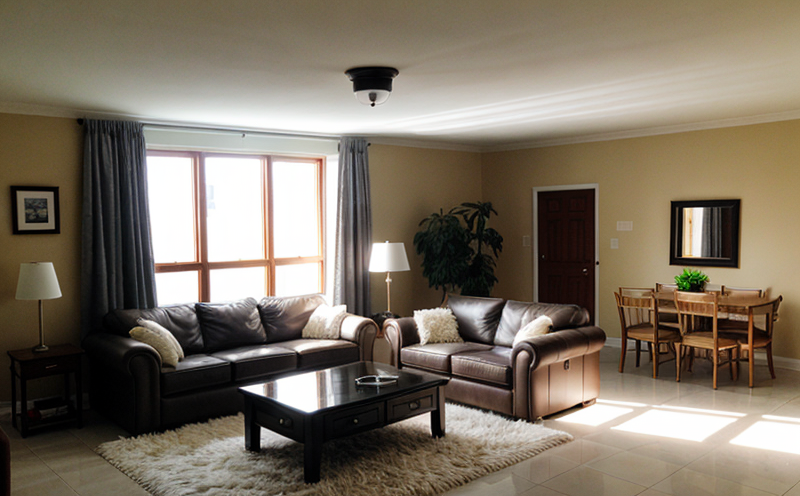IEC 60068 2 30 Humidity Resistance Testing of Indoor Lighting Equipment
The International Electrotechnical Commission (IEC) standard IEC 60068-2-30 specifies the procedure for conducting humidity resistance tests on electrical and electronic products. This standard is essential in ensuring that indoor lighting equipment can withstand the environmental conditions they may encounter during their lifecycle, including condensation, rain, and other moisture-related factors.
The test involves exposing the lighting equipment to a controlled environment with high relative humidity for an extended period. During this process, the temperature of the surrounding air is carefully monitored and maintained within specific parameters set forth by the standard. The purpose is to simulate real-world conditions that may lead to moisture ingress into the product.
The test setup typically includes a chamber capable of maintaining precise temperature and humidity levels. Specimens are placed in this chamber, where they undergo exposure according to predefined time intervals. This allows for accurate measurement of the equipment's performance under humid conditions without compromising its structural integrity or operational functionality.
One of the key aspects of IEC 60068-2-30 is the requirement that specimens be subjected to a range of humidity levels, from dry (low humidity) to saturated. This comprehensive approach ensures thorough testing and validation across various environmental scenarios. Compliance with this standard helps manufacturers ensure their products meet international quality standards and are fit for use in diverse environments.
The test results provide critical insights into the durability and reliability of indoor lighting equipment. By adhering to these rigorous testing protocols, manufacturers can enhance product performance, extend service life, and improve overall customer satisfaction by addressing potential moisture-related issues early on during the development phase.
It is important to note that IEC 60068-2-30 does not merely focus on the physical aspects of humidity resistance but also considers the impact of moisture ingress on electronic components. This holistic approach ensures that lighting equipment remains safe, efficient, and effective in even challenging environments.
- Industry Applications: The use of IEC 60068-2-30 is particularly relevant for manufacturers involved in the design and production of indoor lighting fixtures. This includes but is not limited to residential, commercial, and industrial applications where reliable performance under humid conditions is crucial.
- Quality and Reliability Assurance: Compliance with this standard contributes significantly to the quality assurance process by identifying potential weaknesses early in the product lifecycle. It helps maintain consistent product quality across different production batches and locations.
Scope and Methodology
The scope of IEC 60068-2-30 includes the testing procedures for determining the resistance to moisture ingress in indoor lighting equipment. The methodology involves placing specimens within a controlled environment where relative humidity is increased gradually over time.
During the test, the specimen is exposed to varying humidity levels and temperatures. The duration of exposure can vary depending on the specific requirements set by the standard, ensuring comprehensive testing under different environmental conditions. This approach helps simulate real-world scenarios more accurately than static tests might allow.
The equipment used in these tests includes specialized chambers designed to maintain precise temperature and humidity settings. These chambers are equipped with sensors that continuously monitor internal conditions throughout the test period. Additionally, data loggers provide detailed records of environmental parameters, which can be reviewed post-test for analysis purposes.
Once the specified exposure times have been completed, the specimens are inspected visually to check for any signs of corrosion or other moisture-related damage. Electrical resistance measurements may also be taken to assess changes in performance after being subjected to humidity. These tests ensure that lighting equipment remains functional and safe even when exposed to high levels of humidity.
It's worth noting that the standard provides recommendations regarding specimen preparation, including cleaning procedures and how specimens should be mounted within the test chamber. Proper preparation is crucial for obtaining accurate results from IEC 60068-2-30 testing.
Industry Applications
- Residential Lighting: Ensuring that indoor lighting fixtures in homes are moisture-resistant is critical for maintaining their appearance and functionality. Moisture can lead to cosmetic damage or even affect the internal components of the lighting equipment.
- Commercial Spaces: Offices, retail stores, and other commercial settings often have high humidity levels due to HVAC systems or natural conditions. Testing indoor lighting in accordance with IEC 60068-2-30 helps guarantee that these fixtures perform reliably under such conditions.
- Industrial Environments: Factories, warehouses, and other industrial locations can experience fluctuating humidity levels depending on the time of year or operational activities. Conducting IEC 60068-2-30 testing ensures that lighting equipment remains effective in these challenging environments.
- Hospitality: Hotels, restaurants, and similar establishments frequently encounter high humidity due to climate control systems. Testing indoor lighting according to this standard helps ensure consistent performance and safety standards in such settings.
Quality and Reliability Assurance
The primary goal of IEC 60068-2-30 is to enhance the quality and reliability of indoor lighting equipment. By subjecting specimens to controlled humidity environments, this standard helps identify potential issues early in the product lifecycle. This proactive approach ensures that any design flaws or manufacturing defects are addressed before products reach the market.
Compliance with IEC 60068-2-30 also contributes significantly to maintaining consistent quality across different production batches and locations. It provides a standardized framework for testing, which helps manufacturers achieve uniform results regardless of where they operate globally.
In addition to ensuring product reliability, adherence to this standard fosters trust among consumers by demonstrating a commitment to producing high-quality lighting equipment. This can translate into increased market share and better customer satisfaction.





